Today, many premium watch brands look for that certain “extra element” to get ahead of the competition. In addition to precision mechanical movements with high-end finishing, beautiful decoration and quality dials, manufacturers now also look at what they can do with straps.
If it is true that shoes make the man, then the strap must make the watch.
Not surprisingly, some brands have risen to the fore in their journeys toward originality thanks to collaborations with fashion world icons. What is their ultimate goal: to be different in any way possible? To offer the highest possible quality? Or to use the partner brand’s name to expand its range of potential clients?
Every brand has its own reasons, but ultimately, we as consumers are most interested in how the decorative part of the timekeeper matches our suits, shoes, and belts.
“Men tell me that I’ve saved their marriages. It costs them a fortune in shoes, but it’s cheaper than a divorce.” – Manolo Blahnik
Forgetting the existence of flexible bracelets, rubber, and cheap silicone and for a while and devoting ourselves just to leather and satin, we can make all of our watches elegant, regardless of their inherent characters.
We’re not forgetting the chunky, robust leather straps needed for so-called tool watches – functional timepieces used for work and, really, any situation – but these constitute a chapter in and of itself.
There are special workshops that produce large straps for the enormous watches made by Panerai, Oris, and even Breitling because these have been very trendy in recent years – as have smaller, subtler straps with authentic-looking patina and original stitching, which are currently also very much in vogue.
That the strap forms a certain overall character for the watch is not something to be doubted. And distinguishing your wrist very easily from others while remaining faithful to your favorite watches is easier than it may seem: the magic lies in the strap.
This is also recognized by manufacturers who increasingly supply their timepieces with extra NATO straps, buckles, and/or a variety of leather straps in different colors and styles. And that is where huge possibilities open up.
Adding value with leather
While a gentleman attempts to match the color of a watch strap to the belt of his trousers or even the color of his shoes, women naturally do the same with their handbags. The wristwatch is indeed an accessory whose details can be fine-tuned.
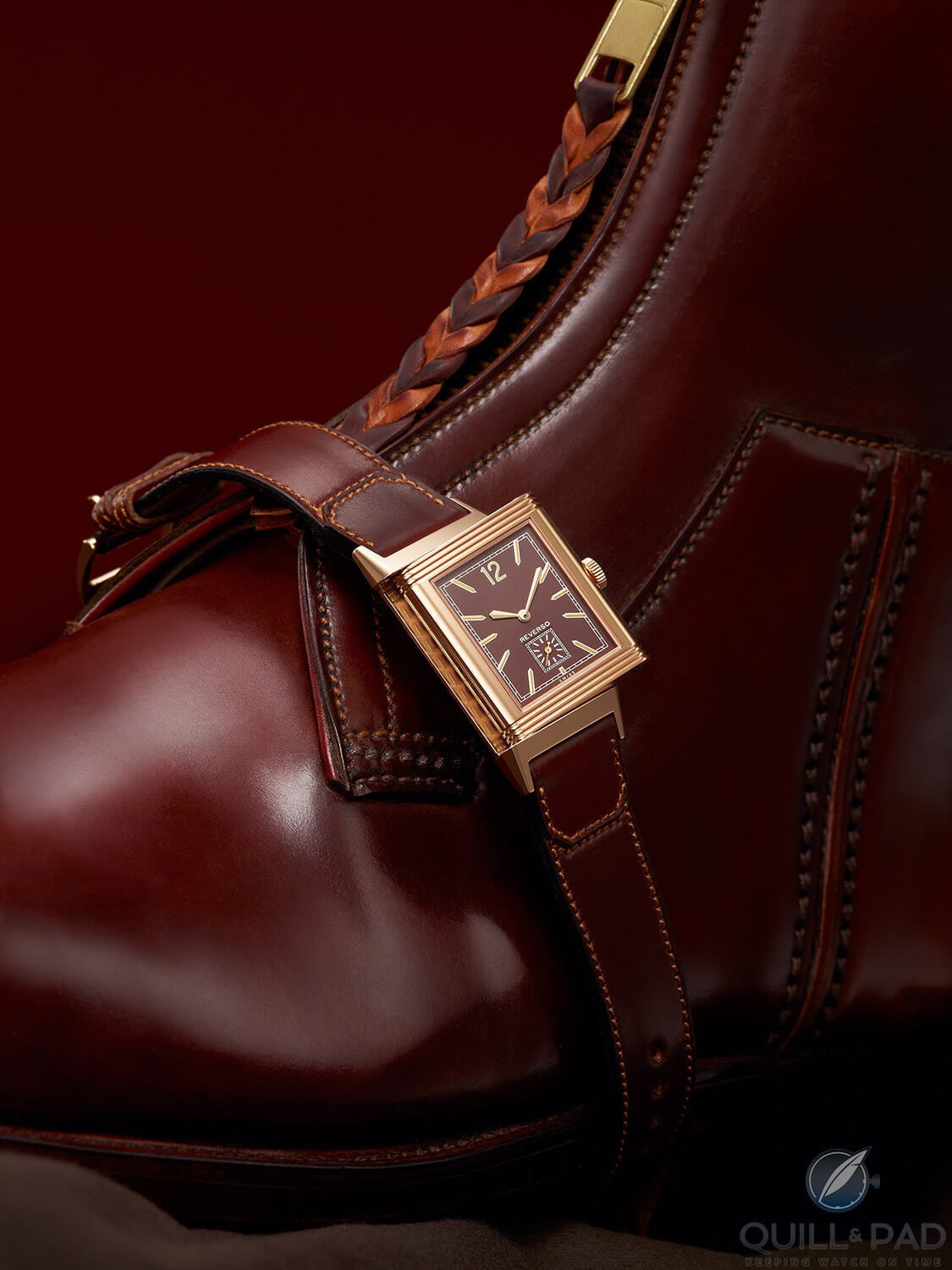
Jaeger-LeCoultre Grande Reverso Ultra-Thin 1931 with chocolate dial and complementary leather strap
This concept goes particularly well with Jaeger-LeCoultre’s eternal icon, the Reverso, which, aside from the personalization possible for the reverse side of its swiveling case, is also offered with a wide portfolio of strap choices. However, before the advent of the Atelier Reverso, which offers more than 5,200 possible combinations of elements, the brand shared its strap vision by partnering with several famous producers of leather.
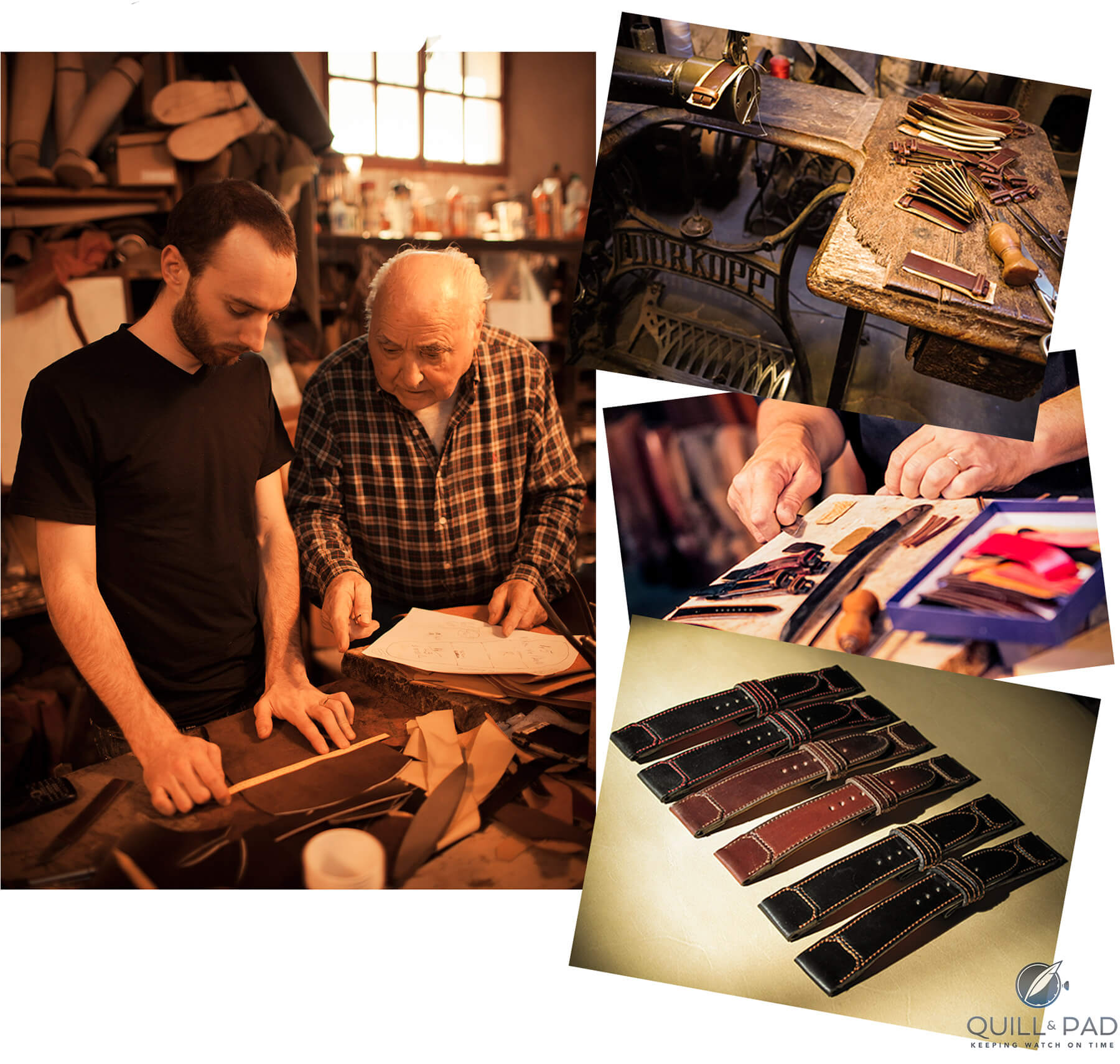
Casa Fagliano atelier in Buenos Aires (photos courtesy Germ+ín-Fagliano)
This began in 2011 with a partnership with a traditional producer of luxurious shoes for wealthy polo players and professional jockeys: the family-owned Casa Fagliano’s beginnings can be traced back to 1892 in Buenos Aires.
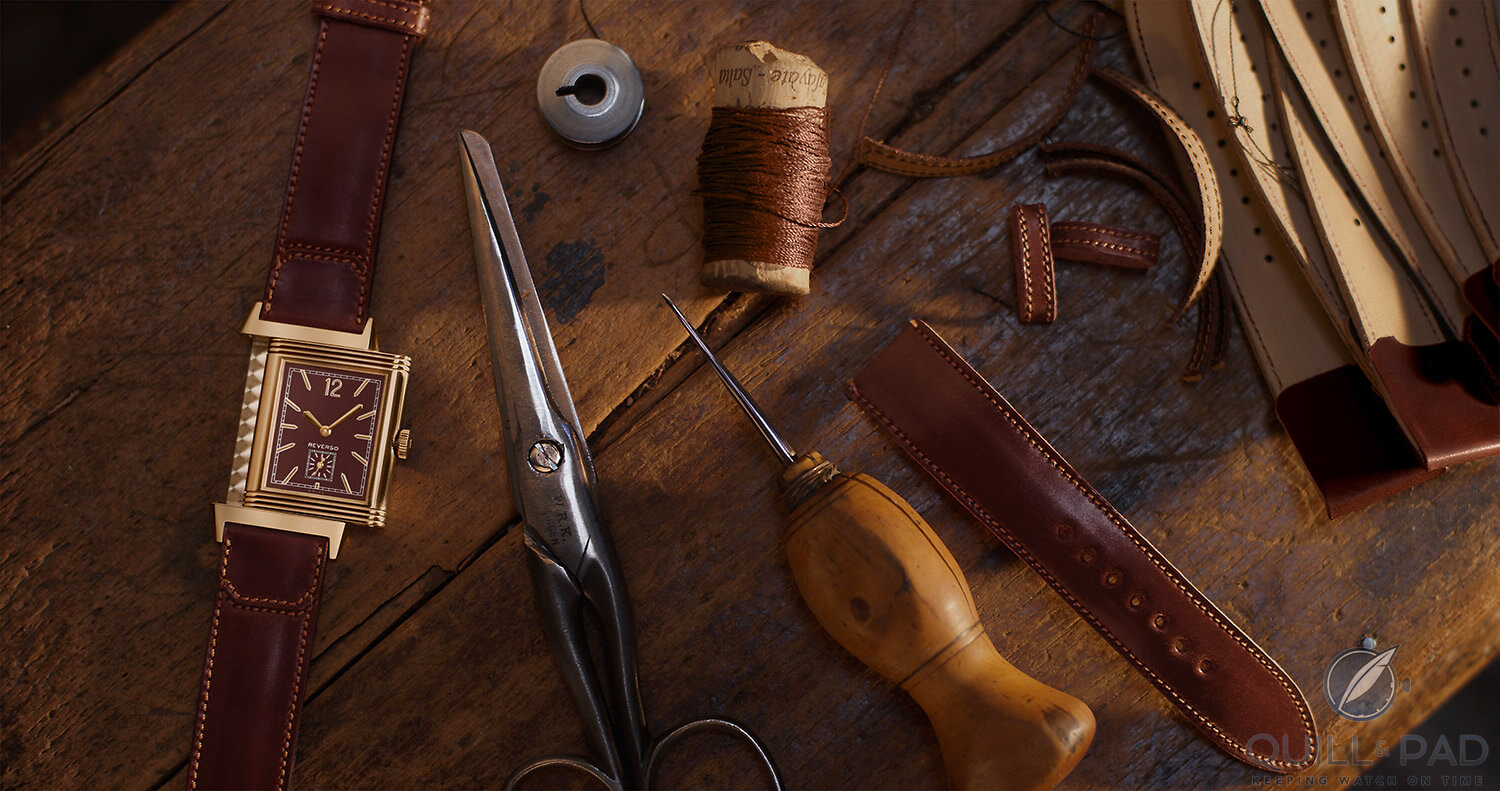
Jaeger-LeCoultre Grande Reverso Ultra Thin 1931 with chocolate-colored dial
To celebrate 80 years of the famous watch that emerged from the needs of polo players, Fagliano provided fine cordovan leather straps in a broad portfolio of unique colors from Bordeaux red to chocolate brown and classic black for the Reverso Ultra Thin 1931.
The success was incredible, and the Le Sentier-based manufacture experienced an upturn in demand for its art deco evergreen.
Fashionable creativity
In fashionable Italy of the 1970s, the return of the avant-garde Reverso watch was strong, setting trends in horological scenes and aiding the comeback of this brand during the ensuing mechanical renaissance in a taste-making market. So as the manufacture was rethinking its leathers, it became obvious it needed to find a new partner on the Apennine peninsula for this market. Even though I find the choice somewhat surprising, as the Richemont Group owns Lancel, a French handbag manufacturer, it chose an Italian competitor.
The choice fell on Milan-based brand Valextra, whose history began with designer Giovanni Fontana in 1937.
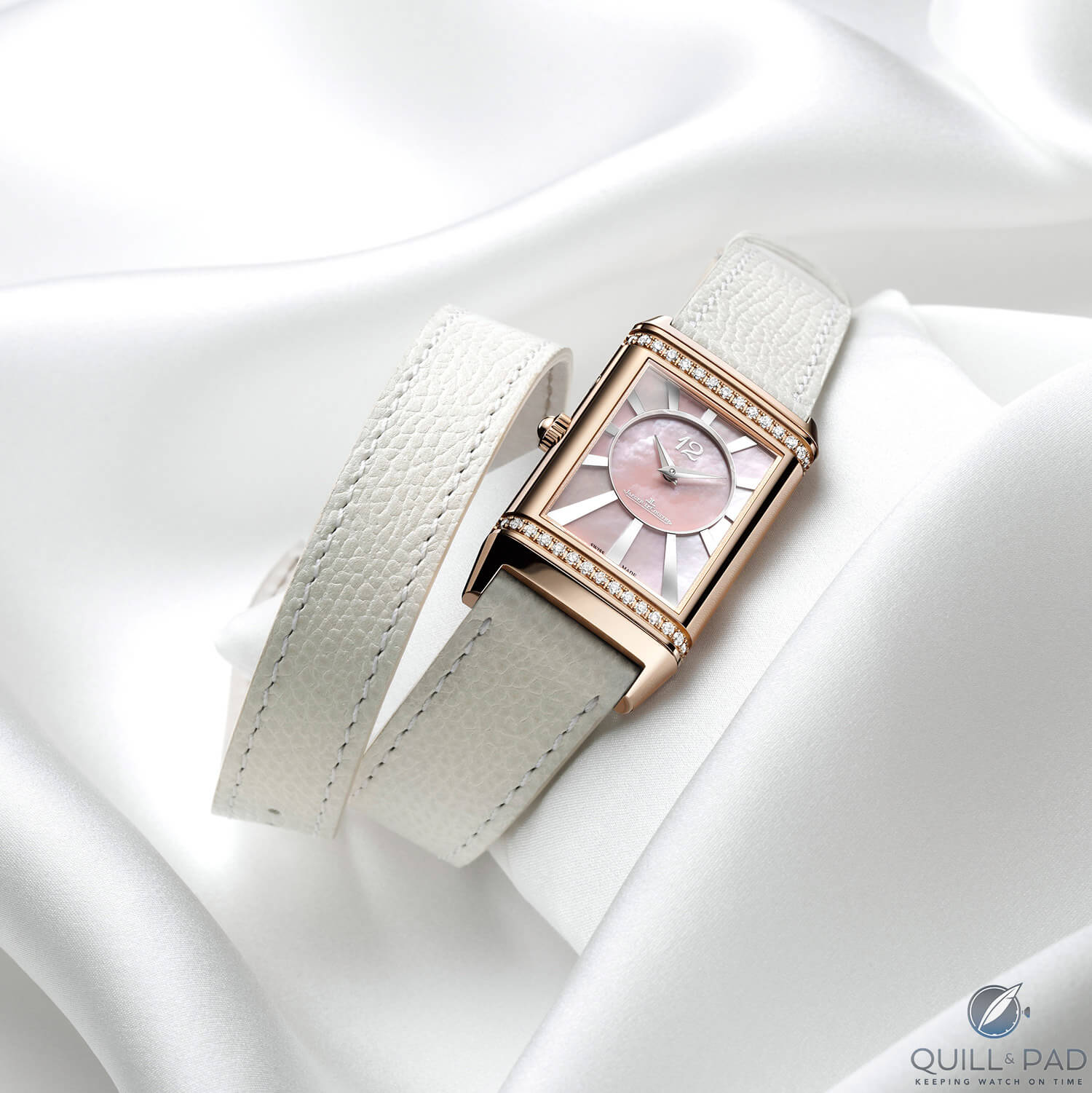
Jaeger-LeCoultre Grande Reverso Lady Ultra Thin Duetto Duo on white Valextra strap
The first joint project arrived in 2012 when Valextra designed the straps for the women’s Reverso Ultra Thin and Ultra Thin Duetto, which wrapped around the wrist twice, emulating an Hermès Double Wrap style.
The main joint project, however, was the creation of a unique clutch bag. While Valextra had had clutches in its collection since 2009, the new Rendez-Vous Clutch went the extra horological mile: instead of a classic pull-through strap on the back to allow a better grip on the elongated bag shape, the manufacturer modified the pull-through strap to accommodate a special edition Rendez-Vous watch.
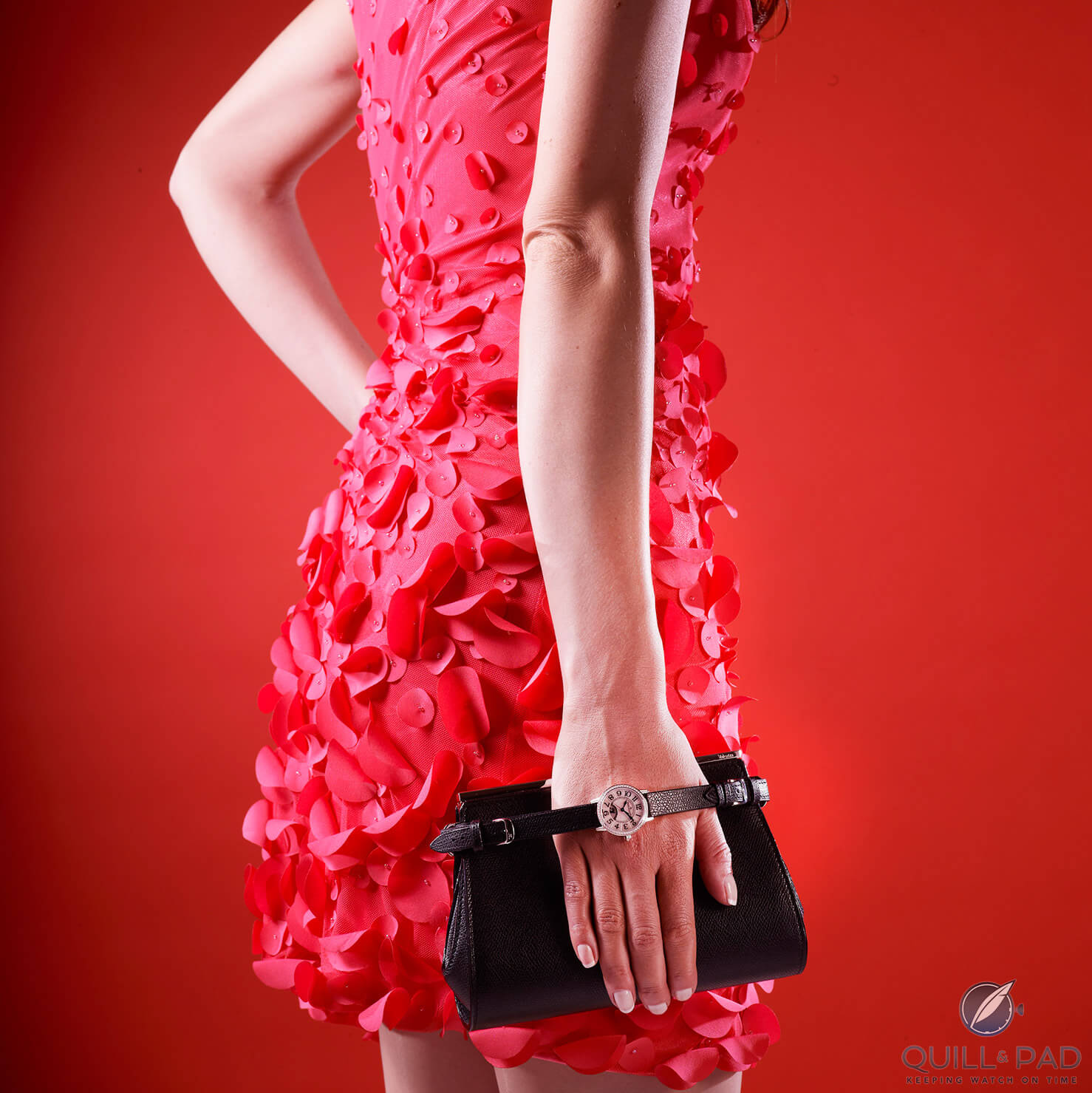
Valextra clutch bag with Jaeger-LeCoultre Rendez-Vous watch
This watch can be unbuckled at any time and put on the wrist. But strapped to the bag like this, it makes for a smart addition to a great evening outfit.
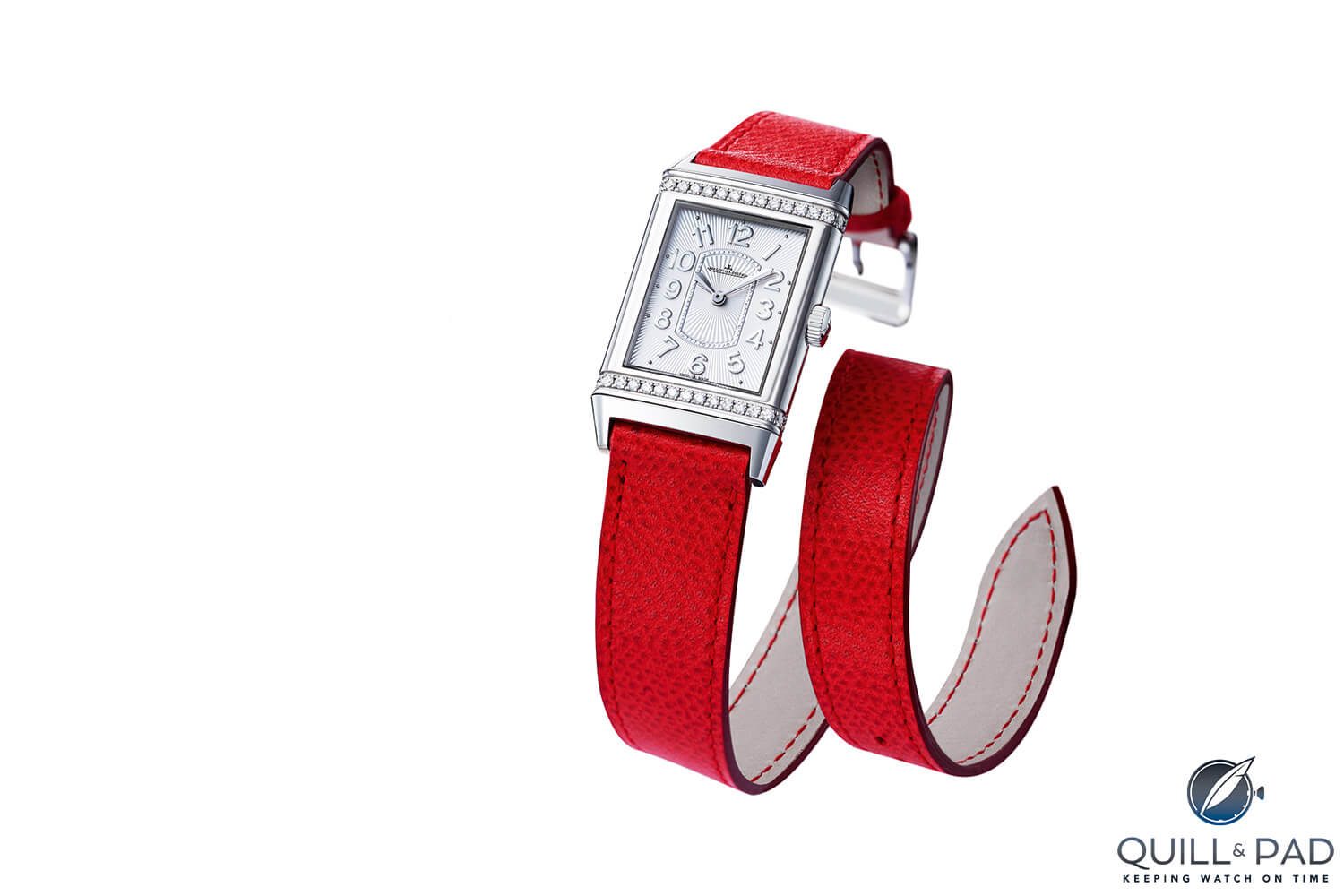
Jaeger-LeCoultre Grande Reverso Lady Ultra Thin by Valextra
And, a third time lucky, a 2013 St. Valentine’s Day edition was lovingly created with appropriate red, bright green, and beige straps that could be purchased only in boutiques. Like today’s Atelier Reverso, this also offered variability in strap design that was only just beginning at that time.
Trendy glamour
It was only a matter of time before renowned shoe manufacturer Christian Louboutin appeared on the watch scene – and this happened in 2016 when Jaeger-LeCoultre partnered with the famous shoe brand. While there was no contrasting red “sole” on the straps – the famous signature element of his shoe creations that helped him pull ahead of competition in 2011 when he battled the legendary Yves Saint Laurent in court – these watch accessories had a lot to offer.

A transparent version of the Jaeger-LeCoultre Atelier Reverso Christian Louboutin from 2016
The watchmaker icon of Switzerland’s romantic Vallée de Joux partnered with the Parisian master of leggy dreams for a special edition of the Atelier Reverso line within the framework of its 85th anniversary, signing a one-year contract for glittering, unique, creatively designed straps.
The absence of a red lining on any of the serial straps was a great surprise, but one that could be rectified by the customer placing a special order. Louboutin’s fashionable concept otherwise comprised sharp straps in unusual shapes, cuts, and staggered layers.
In terms of the fashion world competing with each other in unusual approaches to watchmaking, perhaps Roger Dubuis’s offering that same year was just a little more creative from where I stand: in partnering with renowned Parisian shoemaker Massaro, whose history dates back to 1894, they created a shared vision by the name of Velvet by Massaro.

Roger Dubuis Velvet Massaro, Rita Hayworth version
The couture straps even saw him designing a limited edition of 88 golden-colored examples which I feel would have been identical to both what a Rita Hayworth-style watch strap (and a ten-centimeter heel) would have been.
The two other straps from Massaro’s silver screen trilogy were also seductive in their extraordinary designs: the Greta Garbo version, created with the help of artistic fashion mage Laurence Le Constant, included an unprecedented processing of leather interwoven with feathers. A silver-trimmed version bearing the name of American actress Lana Turner came complete with a line of sewn-in pearls.
Classic over gold: the Hermès standard
It is one thing to be creative and another to shine while doing it – the former is generally achieved by maintaining renowned classic quality, durability, and value. And in the field of straps and handbags, few can reach the level of Hermès.
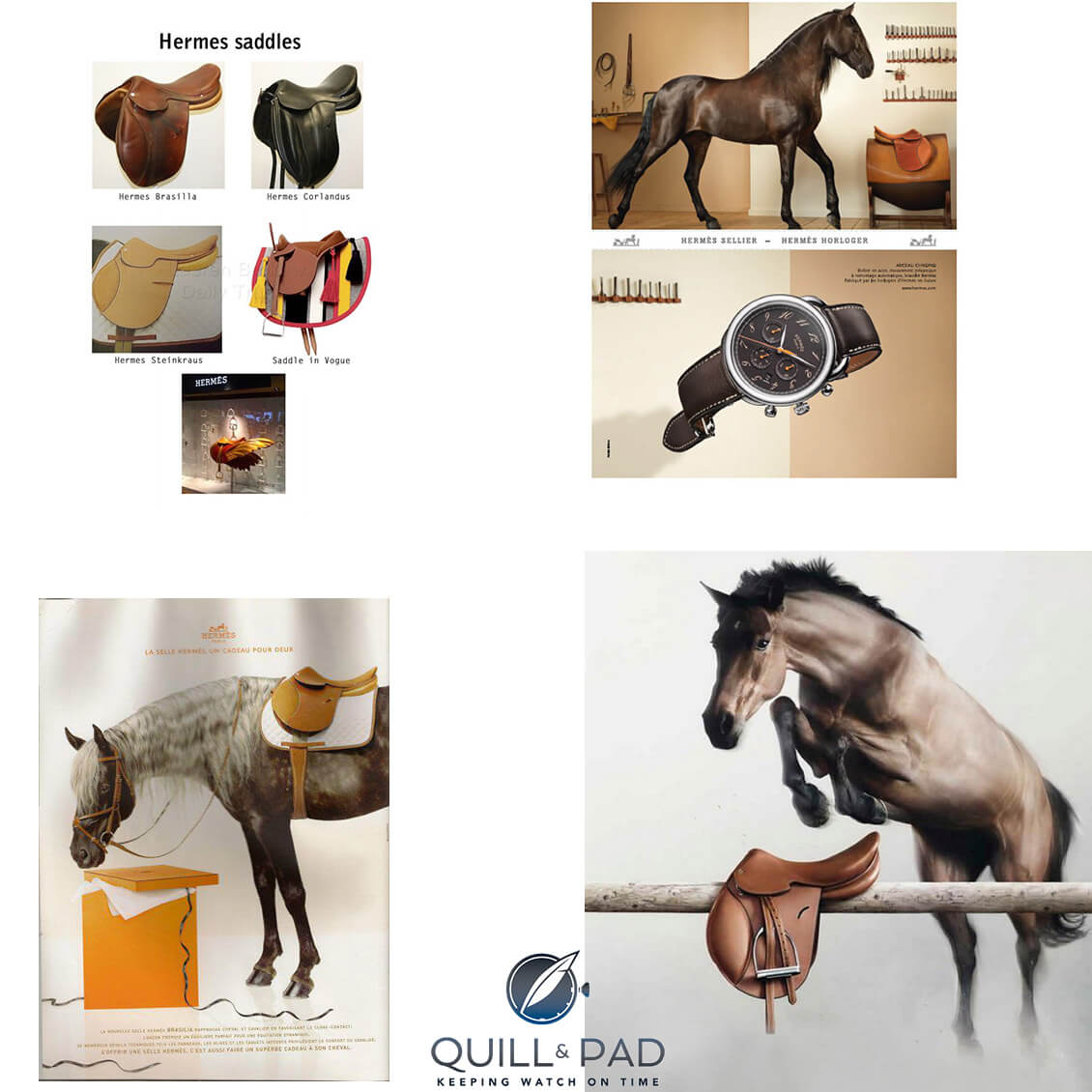
Horses and Hermès
Since its founding in 1837, the world-renowned brand has focused on working with leather. At that time, however, Hermès did not produce luxury handbags and silk scarves sealed by its double-ribbon logo featuring a horse rider, but rather offered riding boots, quilted saddles, and bridles. Hermès made its mark much later in creating straps for wristwatches and “pockets” for pocket watches.
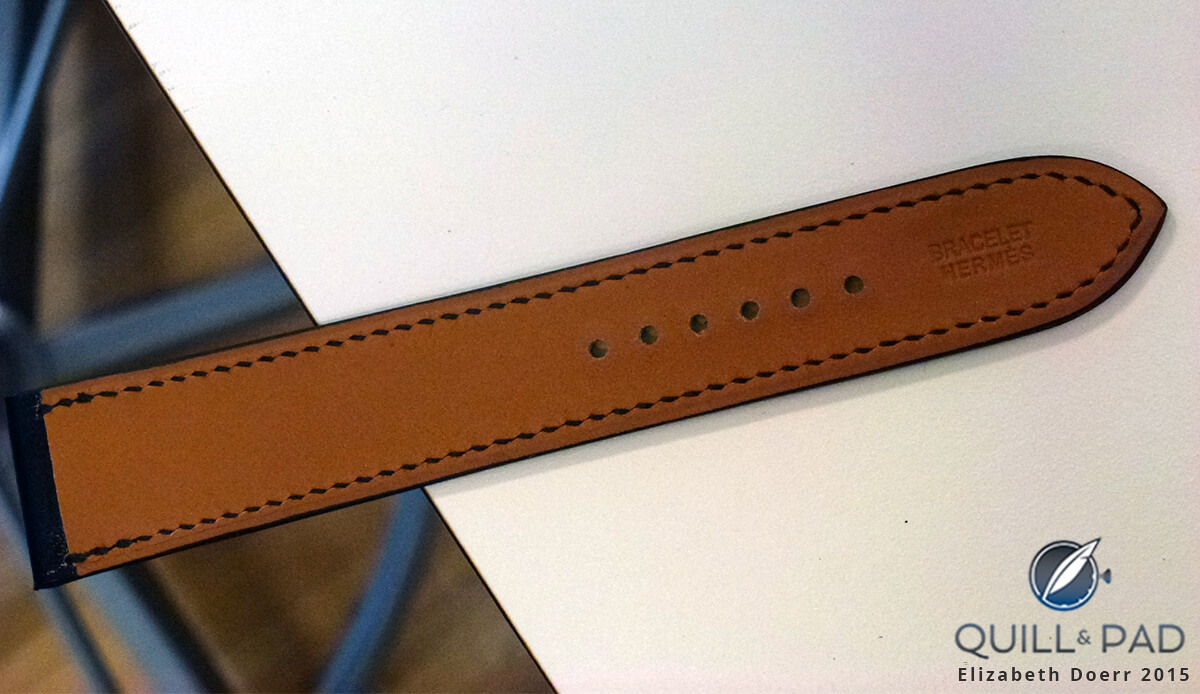
Hermés leather watch strap
At first, however, Hermès worked as a watch retailer for various brands, from Jaeger-LeCoultre, Mido, Rolex, and Universal Genéve to Vacheron Constantin. It began writing its own history in watches in the twentieth century, at a time when it had just started playing with the idea of luxury handbags to compete against the well-established Louis Vuitton.
After all, Hermès’ own skillfully crafted leather goods had produced great demand – which is no different today. Actually, yes, it is different: the demand continues to constantly grow, even for straps, which are very difficult to buy. In fact, it is downright impossible if you didn’t get it on one of Hermès’ own watches, a Parmigiani watch, or the special Apple Watch Hermès edition.
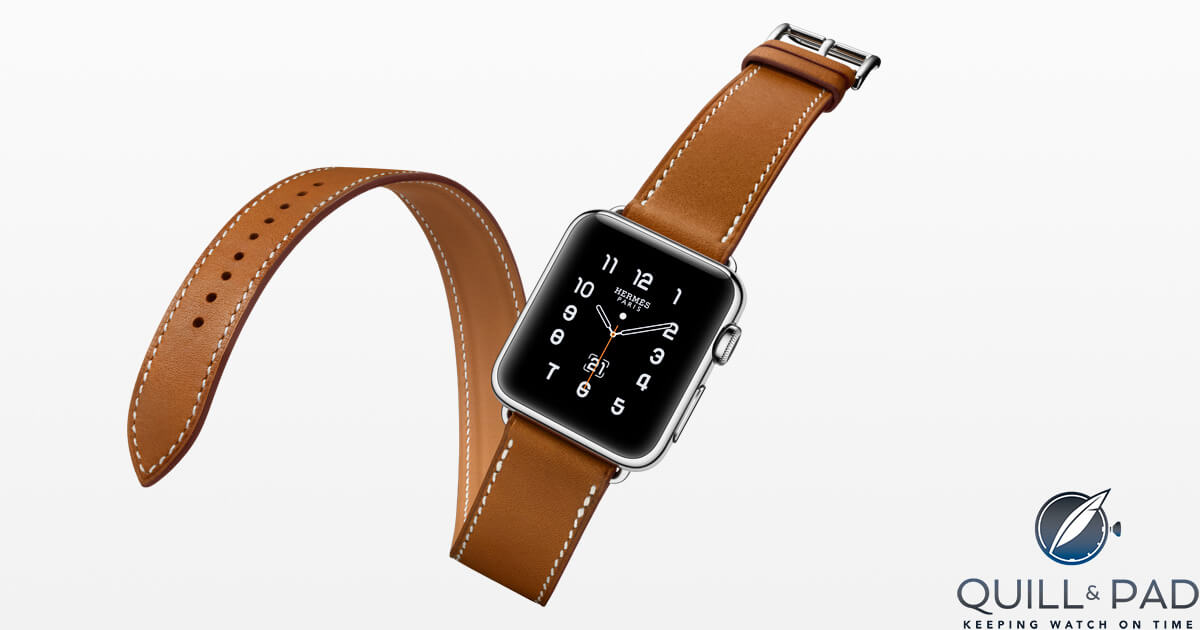
Apple watch by Hermés
These straps are not sold individually as they are intended for the owners of the Hermès brand’s products (and Parmigiani, who as a partner in owning movement manufacturer Vaucher, has special standing). In order to retain exclusivity, the Hermès straps taper into a non-traditional 17 mm buckle, so they do not fit most competitors’ cases.
In the small Swiss town of Brügg, just outside Biel, where La Montre Hermès is located, the straps are made in more than 50 different steps from a portfolio of more than 2,000 colors of leather, of which only one-tenth belongs to watches. From the skin of one two-to-three-year-old alligator only three straps are produced, while around 50 can be made from a calfskin.
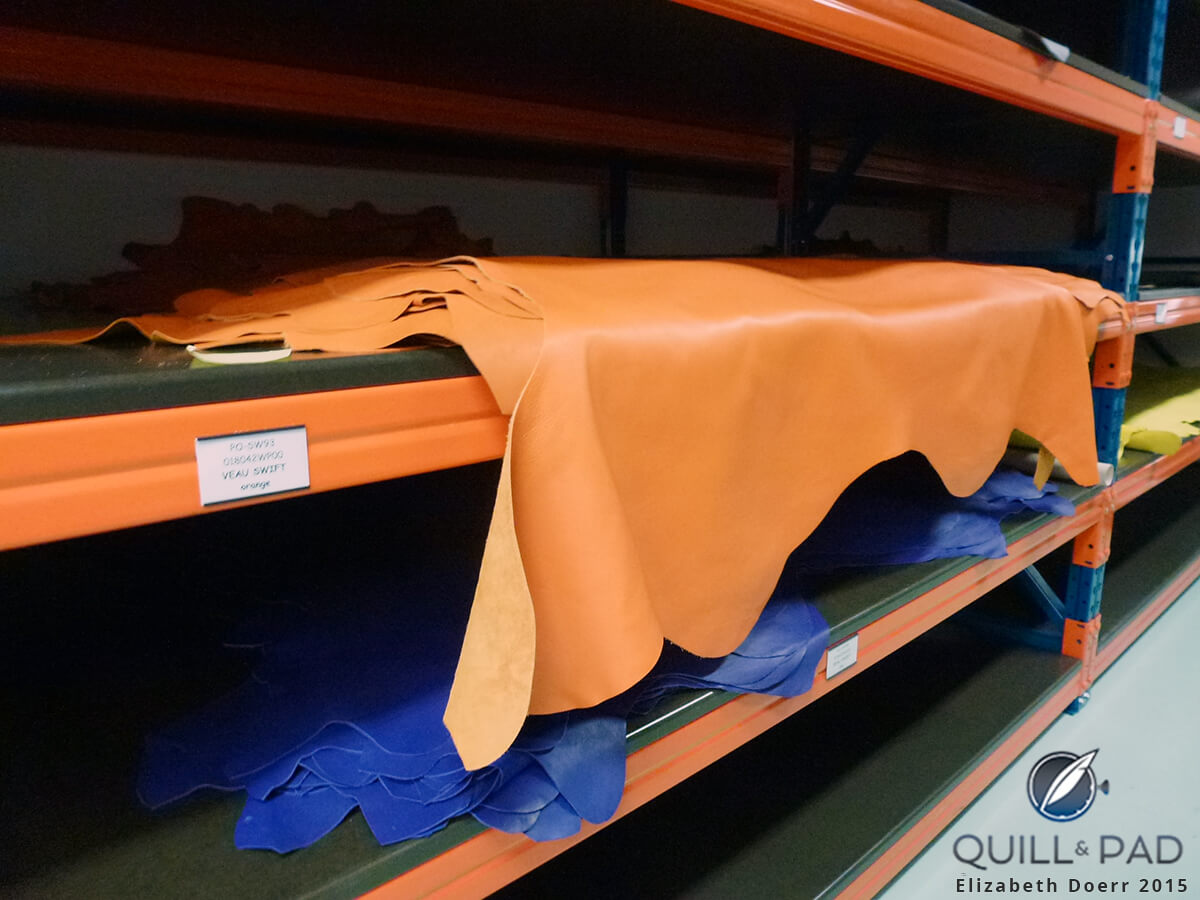
Leather at the Hermés watch strap atelier
Others such as Barenia, French calf, ostrich, goat, and Zermatt are placed on the inside of all straps for hypoallergenic reasons. They are always stitched by hand, evidenced by the seams drawn at a special angle. The stitching on both sides is compressed by hammering. The underside skin is then glued, sanded, and finished with sealing, paraffin, and polishing paper.
Just stitching a regular strap takes almost two hours, but everyone recognizes the quality of the result.
See how an Hermès strap is made in Hermès Watch Straps: Quality Without Compromise, Suppleness Guaranteed.
Fashion in playful rhythm
The family-owned Raymond Weil brand cleverly built on the world of music that surrounds it. That’s why it celebrated 70 years of existence with the Parisian brand Repetto, who mainly produces professional pointe shoes for ballerinas. The repertoire of its products also includes a very comfortable ballerina shoe called Cendrillon, which arose from a request by pop icon Brigitte Bardot, who wore it in 1956’s hit film And God Created Woman.
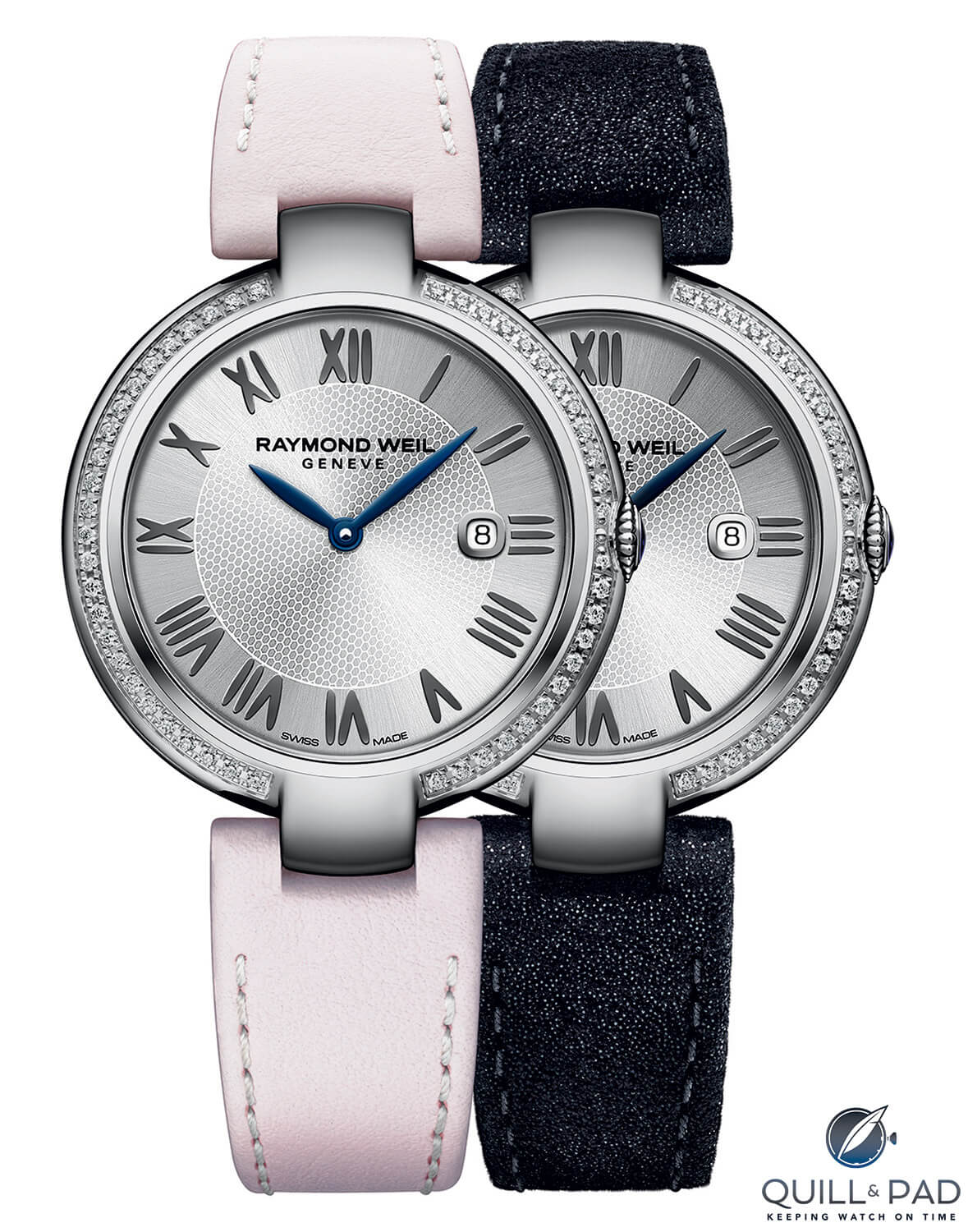
Raymond Weil Shine Etoile with straps by Repetto
Repetto’s history has also included successful cooperations with world-renowned designers like Issey Miyake, Yohji Yamamoto, Comme des Garcons, and Karl Lagerfeld. Repetto’s enormous reputation also attracted Elie Bernheim, grandson of Raymond Weil and today’s managing director of the brand.
Under a contract signed for only two years, Raymond Weil created the women’s watches Shine Etoile with beautiful interchangeable straps in a powder pink and other colors, which can be changed at will to match one’s evening outfit for ballet performances at the theater.
A purely “man”ic affair
Men’s fashion cannot stay away from good leather, either, even though here the cooperations are not quite as eye-catching. Yes, there are overlaps such as the loose cooperation of Italian fashion house Ermenegildo Zegna with Girard-Perregaux, which resulted in a wonderful annual calendar watch that is, sadly, only different from the normal production watch because it offers another logo on the dial.
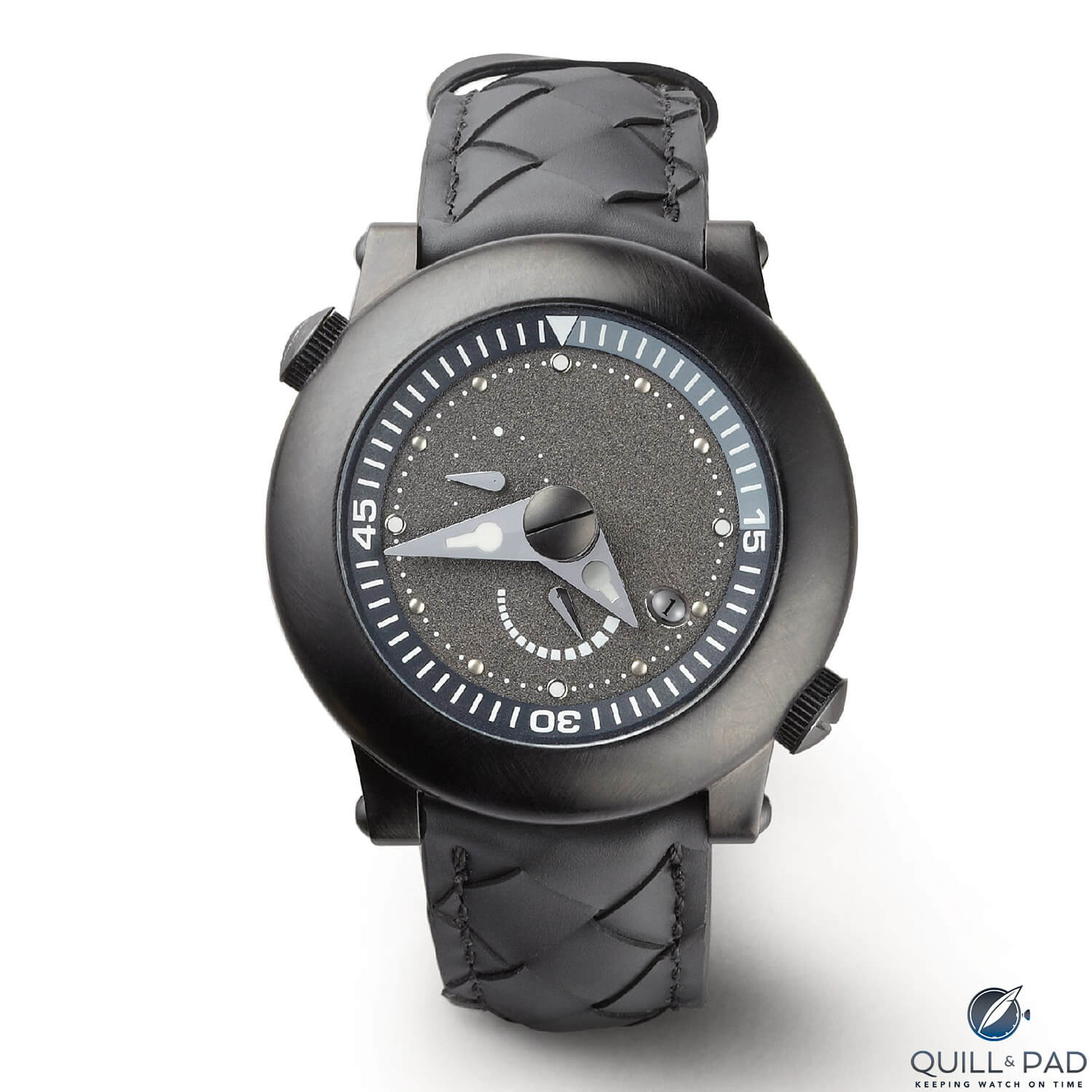
Bottega Veneta Diver
Bottega Veneta, Girard-Perregaux’s sibling brand at the Kering group, suggested somewhat tricky knitted straps and watches with a minimalist design, derailing any magic that it might otherwise have created.
This was done differently by independent watchmaker Christophe Claret, who for his Xtrem 1 deliberately reached out to the young, extravagant fashion brand StingHD, which focuses on woven leather bracelets. The cooperation produced a unique leather strap with a red line of stitching, which intentionally draws attention in combination with a black PVD-coated titanium case whose sapphire crystal with partial metallization also offers a hologram of a skull.

Christophe Claret Xtrem 1
It is outfitted with a flying tourbillon that defies two magnetic fields to display hours and minutes. Fantastic and rebellious at the same time.
Gentlemen’s club
Many brands rely on their own leather production, both for straps and handbags: the ambition of Cartier, Hermès, Louis Vuitton, and Belgian boutique brand Lebeau-Courally is truly admirable.
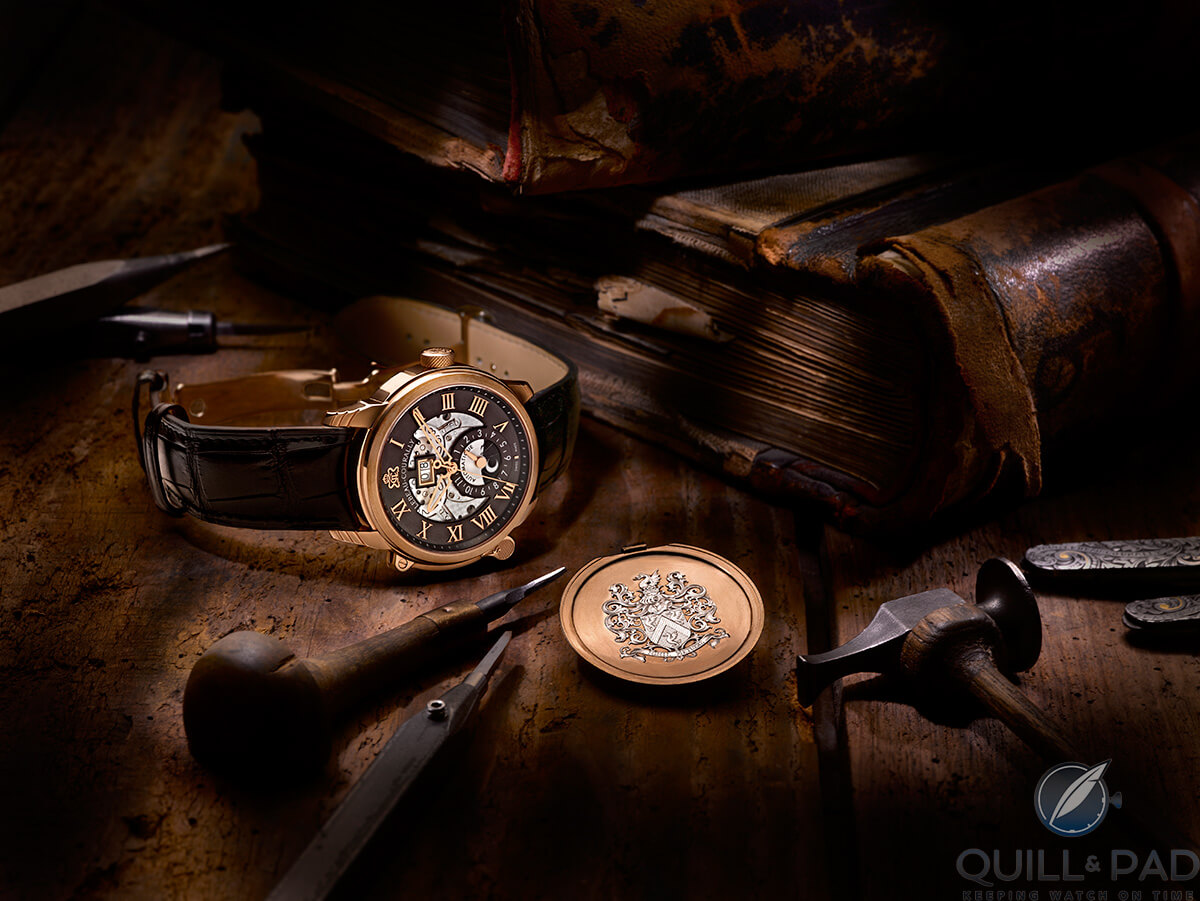
The world of Lebeau-Courally
With its own pelleteria near Florence, Montblanc also belongs to this elite group; and in fact watches are a relatively new field for this multitasking brand. Although it did not start making watches until 1997, the brand has quickly managed to climb to heights in the field.
Luxury footwear combined with a watch strap or belt is easily handled not only by the previously mentioned Casa Fagliano workshop; high riders can also get the same from French fashion house Berluti, who threw in with champion marketeer Hublot to create a commercial partnership. And, honestly, the Classic Fusion watch, which celebrates the 120th anniversary of the legendary shoe brand, is surprisingly tasteful.
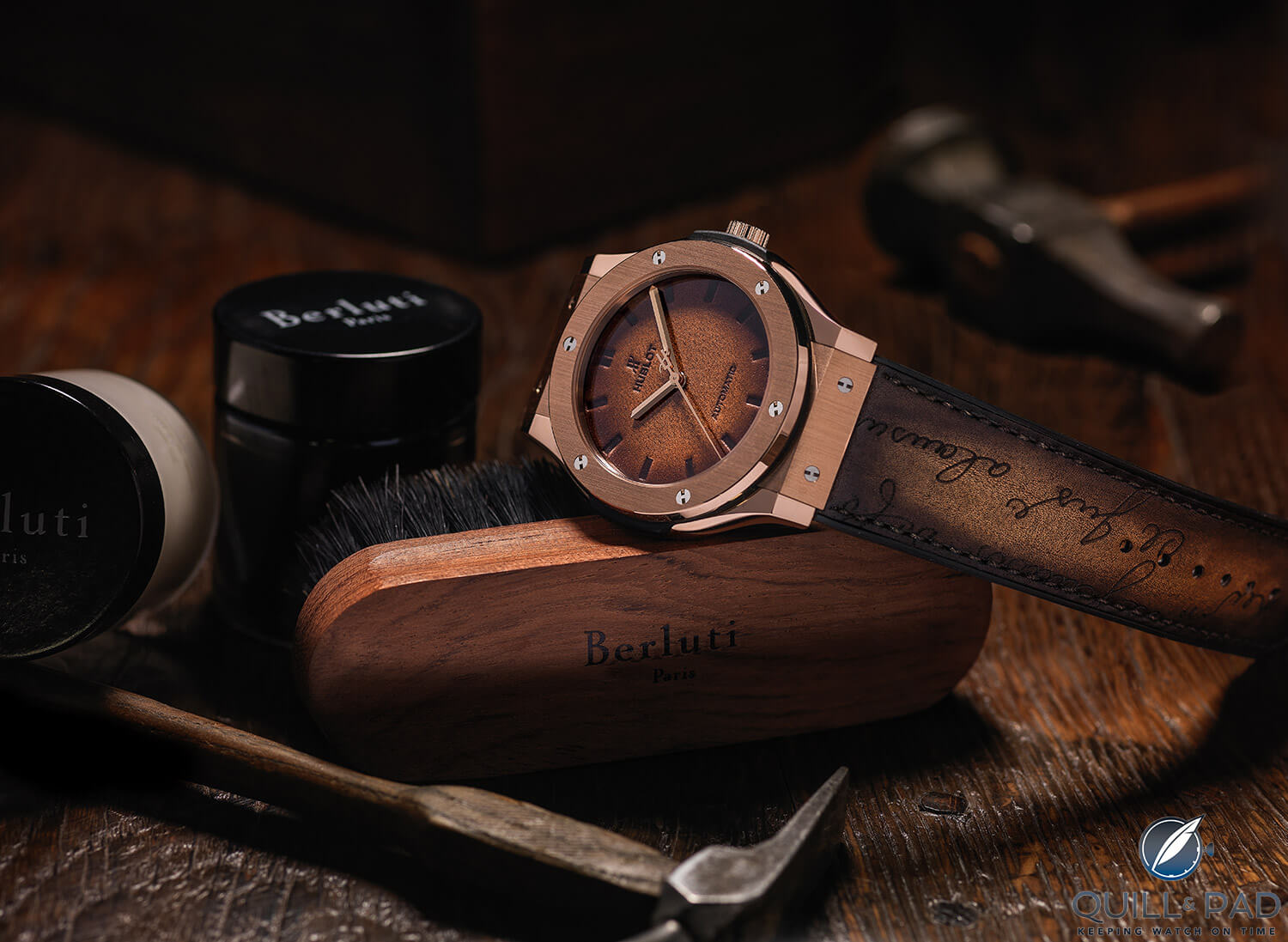
Hublot with Berluti strap
Their collaboration began in the autumn of 2015, with the first two variations revealed at Baselworld 2016. This was followed by a special edition in platinum and a pair of limited edition chronographs. Although in a technical sense they are not powered by revolutionary movements – using ETA and Sellita calibers – they have managed to create a truly interesting product distinguished by the use of intensive patina-highlighted Venetian leather embedded in rubber straps. A whole area of the dial is also decorated with an elegant black and temperamental tobacco color.
In the context of its numerous partnerships, Hublot also made 100 pairs of special tennis shoes with Lavati in black carrying a logo celebrating the all-black Big Bang watch. Gold-colored running shoes by Puma for Usain Bolt, the fastest man on the planet, were delivered with special limited editions of Hublot watches. And let’s also not forget the Puma evo.Speed 1.2 FG, which was part of the Hublot Falcao Classic Fusion Chronograph limited edition celebrating the success of Colombian football striker Radamela Falcao.
In its own world
IWC has had a slightly different approach to its cooperations. In contrast to Hublot, which pursues success with individual projects, IWC has always focused on long-term business ties. As if going with the slogan “no need to hurry,” this brand rarely veers from its “sexy” austere minimalism, except for the Da Vinci model (which is like Swiss puritanical poetry).
Located on the Swiss-German Rhine in the heart of Schaffhausen, and perhaps because it was cut off for many years from the royal valleys of the Swiss Jura, IWC has produced original watches that look little like any others.
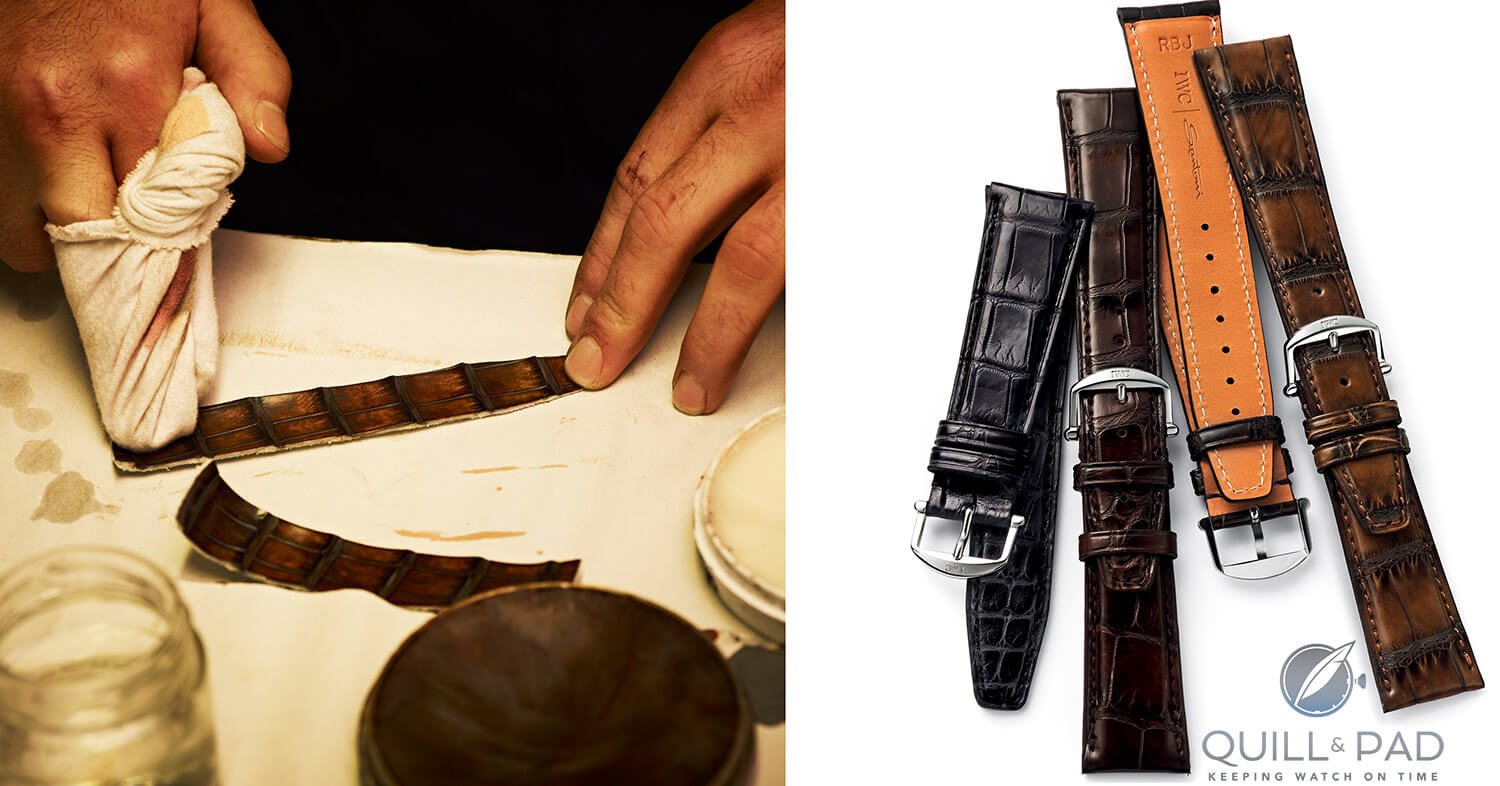
IWC straps by Santoni
Therefore, partners such as Mercedes-Benz and its AMG sports division have maintained partnerships for years. IWC also has a partner like that hailing from the Italian city of Corridon: the legendary brand Santoni, who since 1975 has hand-stitched shoes for individualists.
Santoni also produces high-quality accessories, backpacks, and driver’s shoes – and since 2011 straps for IWC. These feature an orange inner layer based on the color of the outsole and the inside of its boots. Initially, these straps were available for the Portofino edition only, but now they are now fully integrated into other non-limited edition model families.
This reaffirms that IWC does not work on a project-to-project basis, but rather a continuous, long-term basis trying to achieve perfection.
And it is so lovely to see the brands’ creative uses of these “extra elements” from outside their own worlds.
Jan Lidmaňský is a watch collector and journalist from the Czech Republic; follow him on Instagram at @watch_the_food.
Leave a Reply
Want to join the discussion?Feel free to contribute!





















































What a great article, being a leather lover I enjoyed this immensely!
Only one error I’ve noticed, and that is when you said Hérmes watchstraps are near impossible to obtain on its own. That is incorrect as you can walk into any Hérmes store and ask for them to bring out their straps and you can choose and purchase whatever size/type/color you want. When I was in Paris, they even put it all on display for you to see and choose. And yes they have the usual 20mm lug width ones too, not just weird 17 and 19mm.
They’ll give you the usual drivel that it fits only their watches, blah blah blah, which is incorrect because as long as the lug widths are correct it’ll fit virtually any way.
Cheers
Thank you for that information! I had no idea.
Thank you for your feedback. I didn’t know that they offer this possibility now. It’s not possible to get in the Prague boutique, so maybe it will be possible for the future… Anyway, thank you…
About the size: of course, as long you have long enough lugs, it will fit and you will take the extra milimeter without problem :)))
Great article! Thank you for a lot of interesting informations.